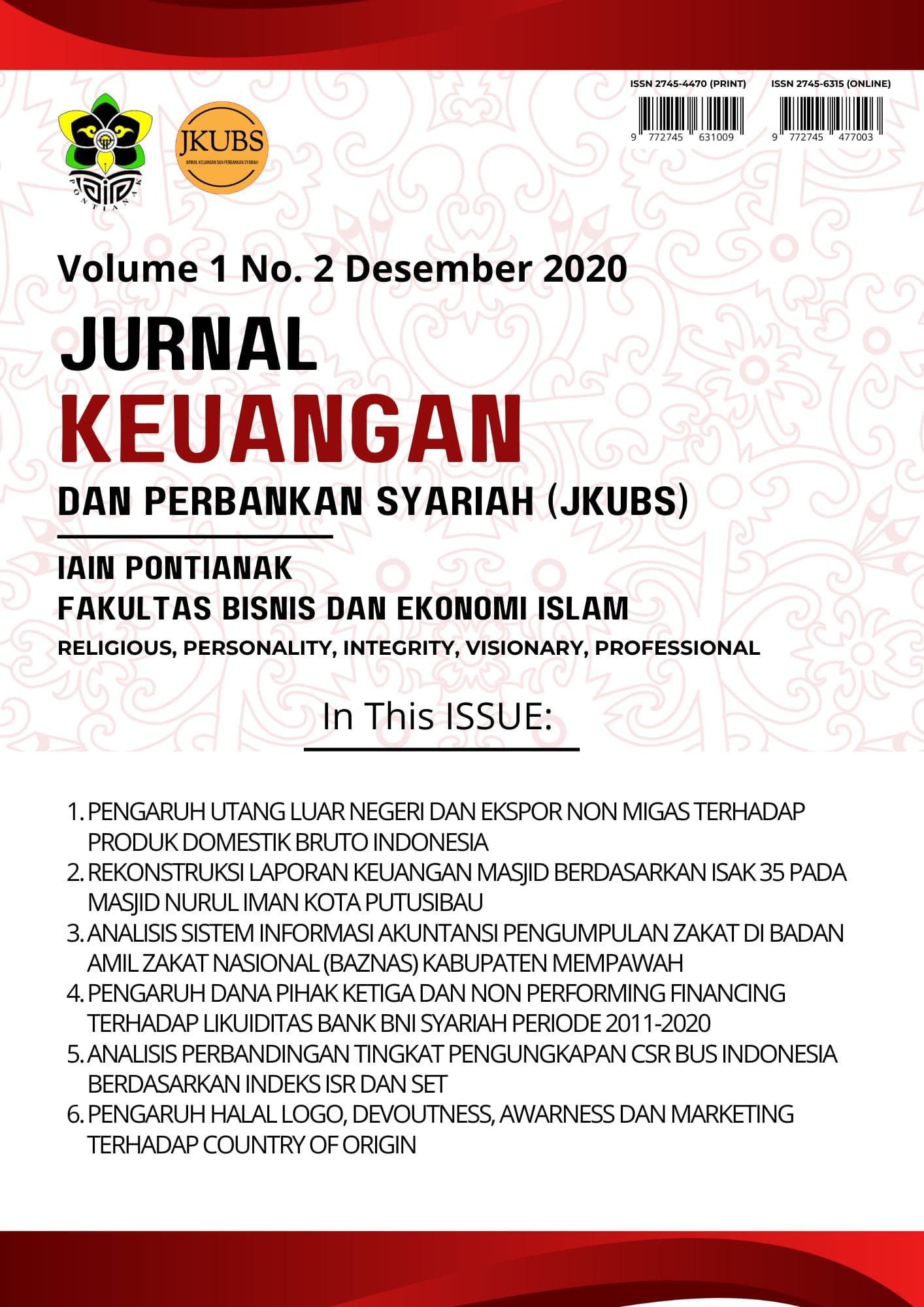PENGARUH HALAL LOGO, DEVOUTNESS, AWARNESS DAN MARKETING TERHADAP COUNTRY OF ORIGIN
DOI:
https://doi.org/10.24260/jkubs.v1i2.306Keywords:
Halal Logo, Devoutness, Awarness, Marketing, Country of OriginAbstract
This study aims to examine the effect of Pontianak Muslims' beliefs on the country of origin in receiving halal products from Malaysia. This research is classified into positivist research. The data source in this research is primary data. While the data collection technique used a questionnaire. The population in this study were all Muslim communities in the city of Pontianak, West Kalimantan. The sample used was purposive sampling. The analysis used is multiple regression with independent variables consisting of: (1) Halal logo, (2) Devoutness, (3) Awarness, (4) Marketing. For the dependent variable, namely Country of origin. The results showed that the Halal Logo variable had a significant effect on the Country of Origin. The Devoutness variable does not have a significant effect on the Country of Origin. The Awarness variable has a significant effect on the Country of Origin. Marketing variables have a significant effect on the Country of Origin.
Downloads
References
Abdul, J., Shaari, N., & Shahira, N. (2010). Dimension of Halal Purchase Intention?: A Preliminary Study Shaari & Arifin. International Review of Business Research Papers, 6(4), 444 - 456. Diambil kembali dari https://doi.org/10.7763/IJSSH.2015.V5.413
Abdulrazak, R, M, A., & Gbadamosi, A. (2017). Trust, Religiosity, and Relationship Marketing: a Conceptual Overview of Consumer Brand loyalty. Society and Business Review, 12 (3), 320 - 339. doi:http;//doi.org/10.1108/SBR-03-2017-004
Abuznaid, S. (t.thn.). Addressing the Muslim Market. Islamic Marketing, 6(26).
Achmat, Zakarija. (2010). Theory of Planned Behavior, Masihkah Relevan? Diambil kembali dari http://zakarija.staff.umm.ac.id/download-as-pdf/umm_blog_article_112. pdf
Adnan, A. (2013). Theoretical framework for Islamic marketing: do we need a new paradigm? International Journal of Business and Social Science, 4 (7).
Ahmad, M, F. (2015). Antecedents of halal brand personality. Journal of Islamic Marketing Emerald Insight, 6 (209-223).
Ajzen, i. (2005). Attitudes, Personality and Behaviour. UK: McGraw-Hill Education.
Aliakbar, J. (2012). Islamic marketing: insights from a critical perspective. Journal of Islamic Marketing, 3(1), 22 - 34
Alserhan, B. A. (2010). Islamic marketing: The birth of a new social science. Journal of Islamic Marketing, 1(1).
Ambali, A. R., & Bakar, A. N. (2014). People's Awareness on Halal Foods and Products: Potential Issues for Policy-makers. Procedia - Social and Behavioral Sciences, 121, 3 - 25.
Ambalia, A, R., & Bakara, A, N. (2014). People’s Awareness on Halal Foods and Products: Potential Issues for Policy-Makers. Social and Behavioral Sciences Procedia.
Aziz, Y. A., & Chok, N. V. (2013). The Role of Halal Awareness, Halal Certification, and Marketing Components in Determining Halal Purchase Intention Among Non-Muslims in Malaysia: A Structural Equation Modeling Approach. Journal of International Food & Agribusiness Marketing, 25(1), 1 - 23.
Bon M, Hussain M. (t.thn.). Chapter 4, Halall. In: Jafari J, Scott N, editors. Tourism in the muslim world. Book series: Bridging tourism theory and practice. Vol. 2. Sommerville (US): Emerald Group Publishing Limited. 47 - 49.
Bonne, K., Vermeir, I., Bergeaud-Blackler, F., & Verbeke, W. (2007). Determinants of halal meat consumption in France. British Food Jourbal, 109(5), 367 - 286.
Brijs, Kris & Bloemer, Josée & Kasper, Hans. (2011). Country-image discourse model: Unraveling meaning, structure, and function of country images. Journal of Business Research, Elsevier, 64(12), 1259 - 1269.
Chiou, Jyh-Shen. (1998). The effect of Attitude, Subjective Norm, and Perceived Behavioral Control on Consumers Purchase Intention: The Moderating effect of Product Knowledge and Attention to Social Comparison Information. Proc. Natl. Sci., 9 (2), 298 - 308.
E, D., H, B., & .M, J. (2010). Analisis Perilaku Konsumen Dalam Pembelian Produk Sayuran Di Pasar Modern Kota Bekasi. Cefars : Jurnal Agribisnis Dan Pengembangan Wilayah, 1(2).
E, Rossa, E, R, Hernan., & Abdelaziz, R, Y. (2014). Do halal certification country of origin and brand name familiarity matter? Asia Pacific Journal of Marketing and Logistics, 26, 665 - 686.
Elias, E. M., Othman, S. N., Yaacob, N. a., & Saifudin, A. M. (2016, Oktober). A Study of Halal Awareness and Knowledge Among Entrepreneur Undergraduates. Project: Islamic Supply Chain Model.
Fishbein, M. A., & Ajzen, I. (1975). Belief, attitude, intention and behaviour: An introduction to theory and research. Reading, MA: Addison-Wesley.
Genc, B and Ay¸se Gu¨ l Bayraktaro?glu. (2017). Exploring the Country of Origin Effect: A Qualitative Analysis of Turkish Consumption. Qualitative Consumer Research Emerald Insight, 14 (25 - 50).
Golnaz, R., Zainalabidin, M., Mad Nasir, S., & Eddie Chiew, F. (667 - 674). Non-Muslims’ awareness of Halal principles and related food. International Food Research Journal, 17, 2010.
Halal Focus. (2011, Maret 2). Diambil kembali dari World Halal Forum 2011 “Towards A Halal Economy–The Power Of Values In Global Markets” Post-Event Report : https://halalfocus.net/malaysia-6th-world-halal-forum-2011-towards-a-halal-economy/
Hamid. (2009, November 18). Halal Focus. Diambil kembali dari Imarat Consultants: https://halalfocus.net/imarat_consultants/
Hashem, T. N., & Al-Rifai, N. A. (2011). The Influence Of Applying Green Marketing Mix By Chemical Industries Companies In Three Arab States In West Asia On Consumer's Mental Image. International Journal of Business and Social Scie, 2 (3).
Hassan, H. & Bojei, J. (2011). The influences of religious attributes of halal products onexport marketing strategy: preliminary findings. Journal for Global BusinessAdvancement, 4 (181-191).
Hong, M., Sun, S., Beg, A. R., & Zhou, Z. (2018). Determinants of halal purchasing behaviour: evidences from China. Journal of Islamic Marketing.
Insch, G. S. & McBride, J. B. (1998). Decomposing the country-of-origin construct: an empirical test of country of design, country of parts and country of assembly. Journal empirical test of country of design, country of parts and country of assembly, 10(4), 69 - 91.
Ireland, J., & Rajabzadeh, S. A. (2011). UAE consumer concerns about halal products. Journal of Islamic Marketing, 2(3), 274 - 283.
Jaelani, A. (2017). Event dan festival di Cirebon: Review bauran pemasaran Syari’ah. IAIN Syekh Nurjati Cirebo, MPRA Paper 77862.
Jallad, N. A. (2008). The concepts of al-halal and al-haram in the Arab-Muslim culture: a translational and lexicographical study. Journal of Theoretical and Experimental Linguistics, 10, 77 - 86.
Judge, R. &. (2008). Perilaku Organisasi. Edisi Keduabelas. Jakarta: Salemba Empat.
Khafifah, N. (2015, Mei 20). Detik Finance. Diambil kembali dari Nielsen: Kepuasan Konsumen RI Meningkat dan Tertinggi Kedua di Dunia: https://finance.detik.com/berita-ekonomi-bisnis/d-2919842/nielsen-kepuasan-konsumen-ri-meningkat-dan-tertinggi-kedua-di-dunia
Khawaja, M. (2001, Oktober 6). Halal Food Authority. hal. 1 - 4. Diambil kembali dari https://www.halalfoodauthority.com/
Kotler, P. (2002). Manajemen Pemasaran, Edisi Millenium, Jilid 2. Jakarta: PT Prenhallindo.
Lada, Suddin, Geoffrey Harvey Tanakinjal dan Hanudin Amin. (2009). Predicting Intention to Choose Halal Products Using theory of Reasoned Action. International Journal of Islamic and Middle Eastern Finance and Management, 2(1).
Linting, I. (2013). Pengaruh Kompetensi, Objektivitas, Independensi dan Kinerja Auditor Internal terhadap Kualitas Audit pada BRI Inspektorat Makassar. Jurnal Akrual, Makasae : Universitas Hasanuddin.
Marzuki, S. Z., Hall, C. M., & Ballantine, P. (2012). Restaurant Manager and Halal Certification in Malaysia. Journal of Foodservice Business Research, 15(2), 195 - 214.
Masnono, A. (2005). Factors influencing the Muslim consumer's level of confidence on Halal logo. penang: eport by Department of Business Administration, University Sains Malaysia.
Menteri Kesehatan dan Menteri Agama RI . (t.thn.). No. 427/Men.Kes/SKBMII/1985 (No.68 Tahun 1985) Tentang Pencantuman Tulisan Halal Pada Label Makanan.
Mohamed, Z., Rezai, G., Shamsudin, M. N., & F.C, E. C. (2008). Halal Logo Consumers' Confidence: What are the important factors? Economics and Technology Management Review, 3, 37 - 45.
Morrow, L., Hansen, M. H., & Person A. W. (2004). The cognitive and affective antecedents of general trust within cooperative organizations. Journal of Managerial Issues, 16(1), 48 - 64.
Nassir Shaari, J. A., Khalique, M., & Aleefah, F. (2014). Halal Restaurant: What Makes Muslim In Kuching Confident? Journal of Economic Development, Management, IT, Finance & Marketing, 6(1), 23.
Noordin, N., Hashim, M., & Samicho, Z. (2009). Value chain of halal certification system: A case of the Malaysia halal industry. Proceedings of the European Mediterranean Conference on Information Systems, Izmir, Turkey. .
Nuradli Ridzwan Shah Mohd. D ali, S. S., Samad, A. A., Ismail, N., & Alwi, S. H. (2017). Halal Products From The Consumers Perception. Malaysia: Faculty of Economy & Muamalat, Islamic University College of Malaysia.
O ? zlem Sand?kc?. (2011). Researching Islamic Marketing: Past And Future Perspectives. Turkey: Faculty of Business Administration.
Oki, A., & Jiwanto, G. (t.thn.). Halal Restaurant: Lifestyle Of Muslim Students In Yogyakarta. Yogyakarta: Faculty of Economics, Universitas Atma Jaya Yogyakarta.
R, A. A., & Bakar, N. A. (2013). Hal?l food and products in Malaysia: People's awareness and policy implications. Intellectual Discourse, 21(1), 7 - 32.
Rahim, N. F. (2017). Consumer behaviour, perception and planning towards Halal marketing. Advances in Islamic Finance, Marketing, and Management: An Asian Perspective, 271 - 307.
Regenstein, J., Chaudry, M., & Chaudry, M. (2003). The Kosher and Halal Food laws. Comprehensive Reviews in Food Science and Food Safety, 2(3), 11 - 127.
Regenstein, J., Chaudry, M., & Regenstein, C. (2006). The Kosher and Halal Food Laws. Comprehensive Reviews in Food Science and Food Safety, 2(3). Diambil kembali dari https://doi.org/10.1111/j.1541-4337.2003.tb00018.x
Rehman, M. A., & Shahbaz, M. (2010). The relationship between religiosity and new product adoption. Journal of Islamic Marketing, 1(1), 63 - 69.
Rios, R. E., Riquelme, H., & Abdelaziz, Y. (2014). Do halal certification country of origin and brand name familiarity matter? Asia Pacific Journal of Marketing and Logistics, 26(5), 665 - 686.
Run, E. C., Butt, M. M., & Fam, K. S. (2010). Attitudes towards offensive advertising: Malaysian Muslims' views. Journal of Islamic Marketing, 1(1), 25 - 36.
Setiadi, N.J. (2003). Perilaku Konsumen : Konsep dan Implikasi Untuk Strategi dan Penelitian Pemasaran. Jakarta: Kencana.
Shaari, J, A, N, Khalique, M., & Aleefah, F. (2014). Halal Restaurant: What Makes Muslim In Kuching Confident? Journal of Economic Development, Management, IT, Finance and Marketing, 6 (1).
Shaari, Jamal Abdul Nassir and Nur Shahira bt Mohd. (2009). Dimension of Halal Puchase Intention: A Preliminary Study. Malaysia: Faculty of Economics and Business, Universiti Malaysia Sarawak.
Shafie, S., & Othman, P. D. (2003, November 15). Issues in Halal Packaging: A Conceptual Paper sources. Diambil kembali dari http://cscanada.net/index.php/ibm/article/viewFile/j.ibm.1923842820120502.1080/pdf
Sholahudin, R. (2013). Pengaruh Green Marketing Terhadap Keputusan pembelian ADES. Surakarta: Universitas Sebelas Maret.
Siala, H. (2013). Religious influences on consumers high-involvement purchasing decisions. Journal of Services Marketing, 27(7), 579 - 589.
Skusen, M. (2005). Sang Maestro Teori-teori Ekonomi Modern. Jakarta: Prenada.
Stanton, W. J. (1984). Fundamentals of Marketing. 8 th. Edition. . Uk: Mc Graw Hill.
Tjiptono, F. (t.thn.). Pemasaran Jasa-Prinsip. Penerapan, dan Penelitian. Yogyakarta: ANDI.
Veale, R., Quester, P., Vogt, C., & Fesenmaier, D. (2007). Personal self-confidence: towards the development of a reliable measurement scale. Presented at the 2007 ANZMAC conference Expanding the functional information search model. Presented at the 2007 ANZMAC conference.
Yunus, A. B., Chik, D. W., & Mohamad, M. B. (2010). The Concept of Halalan Tayyiba and Its Application in Products Marketing : A. International Journal of Business and Social Science, 1(3), 239 - 248.
Yusoff, H. M. (2004). Industry Standards Committee on Halal Standards (ISCI). Standard and Quality News, 4 - 5.
Yuswohady et. al. (2015). Marketing To The Middle Class Muslim Cetakan Kedua. Jakarta: Gramedia.
ZAILANI, S. H., ARRIFIN, Z., WAHID, N., OTHMAN, R., & FERNANDO, Y. (2010). Halal traceability and halal tracking systems in strengthening halal food supply chain for food industry in Malaysia. Journal of food Technology, 8(3), 74 - 81.
Zakaria, Z. (2008). TAPPING INTO THE WORLD HALAL MARKET: SOME DISCUSSIONS ON MALAYSIAN LAWS AND STANDARDS. JURNAL SYARIAH, 16(3), 603 - 616.
Downloads
Published
How to Cite
Issue
Section
License
Copyright (c) 2025 Sabirin sabirin, Muhammad Fahmi

This work is licensed under a Creative Commons Attribution-NonCommercial 4.0 International License.





